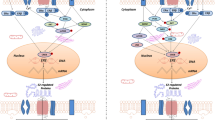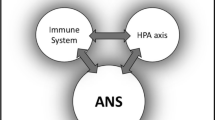Abstract
Changes in activity of the hypothalamic–pituitary–adrenal (HPA) axis were examined in adult, prenatally stressed male rats in the experimental depression model of ‘learned helplessness’. It was shown that in males descending from intact mothers a depressive-like state was accompanied by an increase in activity of the entire HPA axis. Namely, expression of corticotropin-releasing hormone (CRH) in the hypothalamic paraventricular nucleus (PVN) increased coupled to a rise in plasma levels of ACTH and corticosterone as well as in adrenal weight. At the same time, in males born to mothers who suffered stress during the last week of pregnancy a decrease was detected in activity both of the central (hypothalamus) and peripheral (adrenal cortex) parts of this regulatory hormonal axis, analogous to that we revealed previously in the ‘stress–restress’ experimental model. It is concluded that prenatal stress modifies the sensitivity of animals to inescapable intense stress impacts, as manifested in the specific pattern of HPA axis activity after stressing.
Similar content being viewed by others
References
Makham, J.A. and Koenig, J.I., Prenatal stress: role in psychotic and depressive diseases, Psychopharmacology (Berl.), 2011, vol. 214, pp. 89–106.
Swanson, J.M., Entringer, S., Buss, C., and Wadhwa, P.D., Developmental origins of health and disease: environmental exposures, Semin. Reprod. Med., 2009, vol. 27, pp. 391–402.
Van den Bergh, B.R.H., Calster, B.V., Smits, T., Van Huffel, S., and Lagae, L., Antenatal maternal anxiety is related to HPA-axis dysregulation and self-reported depressive symptoms in adolescence: A prospective study on the fetal origins of depressed mood, Neuropsychopharmacol., 2008, vol. 33, pp. 536–545.
Weinstock, M., Intrauterine factors as determinants of depressive disorder, Isr. J. Psychiatry Relat. Sci., 2010, vol. 47, pp. 36–45.
Raposa, E., Hammen, C., Brennan, P., and Najman, J., The long-term effects of maternal depression: early childhood physical health as a pathway to offspring depression, J. Adolesc Health., 2014, vol. 54. pp. 88–93.
Glover, V., Prenatal stress and its effects on the fetus and the child: possible underlying biological mechanisms, Adv. Neurobiol., 2015, vol. 10, pp. 269–283.
Baker, S.L., Mileva, G., Huta, V., and Bielajew, C., In utero programming alters adult response to chronic mild stress: Part 3 of a longitudinal study, Brain Res., 2014, vol. 1588, pp. 175–189.
Mairesse, J., Van Camp, G., Gatta, E., Marrocco, J., Reynaert, M.L., Consolazione, M., Morley-Fletcher, S., Nicoletti, F., and Maccari, S., Sleep in prenatally restraint stressed rats, a model of mixed anxiety-depressive disorder, Adv. Neurobiol., 2015, vol. 10, pp. 27–44.
Weinstock, M., Changes induced by prenatal stress in behavior and brain morphology: can they be prevented or reversed? Adv. Neurobiol., 2015, vol. 10, pp. 3–25.
Frodl, T. and O’Keane, V., How does the brain deal with cumulative stress? A review with focus on developmental stress, HPA axis function and hippocampal structure in humans, Neurobiol. Dis., 2013, vol. 52, pp. 24–37.
Pariante, C.M., Risk factors for development of depression and psychosis, Ann. N. Y. Acad. Sci., 2009, vol. 1179, pp. 144–152.
Grigoryan, G.A., Dygalo, N.N., Gekht, A. B., Stepanichev, M.Yu., and Gulyaeva, N.V., Molecular-cellular mechanisms of depression. The role of glucorticoids, cytokines, neurotransmitters and trophic factors in genesis of depressive disorders, Uspekhi Fiziol. Nauk, 2014, vol. 45, pp. 3–19.
Pariante, C.M. and Lightman, S.L., The HPA axis in major depression: classical theories and new developments, Trends Neurosci., 2008, vol. 39, pp. 464–468.
Pariante, C.M. and Miller, A.H., Glucocorticoid receptors in major depression: relevance to pathophysiology and treatment, Biol. Psychiatry, 2001, vol. 49, pp. 391–404.
Schüle, C., Baghai, T.C., Eser, D., Häfner, S., Born, C., Herrmann, S., and Rupprecht, R., The combined dexamethasone/CRH Test (DEX/CRH test) and prediction of acute treatment response in major depression, PLoS One, 2009, vol. 4, e4324.
Smith, K.M., The diagnosis of depression: current and emerging methods, Compr. Psychiatry, 2013, vol. 54, pp. 1–6.
Fountoulakis, K.N., Gonda, X., Rihmer, Z., Fokas, C., and Iacovides, A., Revisiting the Dexamethasone Suppression Test in unipolar major depression: an exploratory study, Ann. Gen Psychiatry, 2008, vol. 7: 22.
Stepanichev, M., Dygalo, N.N., Grigoryan, G., Shishkina, G.T., and Gulyaeva, N., Rodent models of depression: neurotrophic and neuroinflammatory biomarkers, BioMed. Res. Intern., 2014, vol. 2014, Article ID932757.
Pivina, S.G., Rakitskaya, V.V., Smolensky, I.V., Akulova, V.K., and Ordyan, N.E., Modification of neurohormones expression in hypothalamus of male rats experienced prenatal stress in the model of posttraumatic stress disorder, Zh. Evol. Biokhim. Fiziol., 2014, vol. 50, pp. 305–311.
LoLordo, V.M., Learned helplessness and depression, Animal Research and Human Health, Carroll, M.E., Overmier, J.B., and Washington, D.C., Eds., Am. Psychol. Assoc., 2001, pp. 63–77.
Zhukov, D.A., The reflection of adaptive component of rat’s behavior in reaction of pituitary–adrenal system to dexamethasone, Fiziol. Zh. im. I.M. Sechenova, 1990, vol. 76, pp. 1090–1098.
Maric, N.P. and Adzic, M., Pharmacological modulation of HPA axis in depression—new avenues for potential therapeutic benefits, Psychiatr. Danub., 2013, vol. 25, pp. 299–305.
Renoi, T., Pang, T.Y., and Lanfumey, L., Drug withdrawal-induced depression: serotonergic and plasticity changes in animal models, Neurosci. Biobehav. Rev., 2012, vol. 36, pp. 696–726.
Avgustinovich, D.F., Alekseyenko, O.V., Bakshtanovskaya, I.V., Koryakina, L.A., Lipina, T.V., Tenditnik, M.V., Bondar, N.P., Kovalenko, I.L., and Kudryavtseva, N.N., Dynamic changes of seroninergic and dopaminergic brain activity in process of anxious depression development: experimental investigation, Uspekhi Fiziol. Nauk, 2004, vol. 35, pp. 19–40.
Wiborg, O., Chronic mild stress for modeling anhedonia, Cell Tissue Res., 2013, vol. 354, pp. 155–169.
El Khoury, A., Gruber, S.H., Mork, A., and Mathe, A.A., Adult life behavioral consequences of early maternal separation are alleviated by escitalopram treatment in a rat model of depression, Prog. Neuropsychopharmacol. Biol. Psychiatry, 2006, vol. 30, pp. 535–540.
Mironova, V., Pivina, S.G., and Rybnikova, E., Effect of inescapable stress in rodent models of depression and posttraumatic stress disorder on CRH and vasopressin immunoreactivity in the hypothalamic paraventricular nucleus, Acta Physiologica Hungarica, 2013, vol. 100, pp. 395–410.
Liberzon, I., Krstov, M., and Young, E.A., Stress–restress: effects on ACTH and fast feedback, Psychoneuroendocrinol., 1997, vol. 22, pp. 443–453.
Yehuda, R. and Antelman, S.M., Criteria for evaluating animal models of posttraumatic stress disorder, Biol. Psychiatry, 1993, vol. 33, pp. 479–486.
Yehuda, R. and Seckl, J., Stress-related psychiatric disorders with low cortisol levels: a metabolic hypothesis, Endocrinology, 2011, vol. 152, pp. 4496–4503.
Ordyan, N.E. and Pivina, S.G., The characteristics of behavior and pituitary–adrenal system responsiveness to stress in rats experienced prenatal stress, Ros. Fiziol. Zh. im. I.M. Sechenova, 2003, vol. 89, pp. 52–59.
Author information
Authors and Affiliations
Corresponding author
Additional information
Original Russian Text © N.E. Ordyan, S.G. Pivina, V.V. Rakitskaya, V.K. Akulova, 2016, published in Zhurnal Evolyutsionnoi Biokhimii i Fiziologii, 2016, Vol. 52, No. 1, pp. 51—57.
Rights and permissions
About this article
Cite this article
Ordyan, N.E., Pivina, S.G., Rakitskaya, V.V. et al. Activity of the hypothalamic–pituitary–adrenal axis of prenatally stressed male rats in experimental model of depression. J Evol Biochem Phys 52, 56–63 (2016). https://doi.org/10.1134/S0022093016010063
Received:
Published:
Issue Date:
DOI: https://doi.org/10.1134/S0022093016010063




